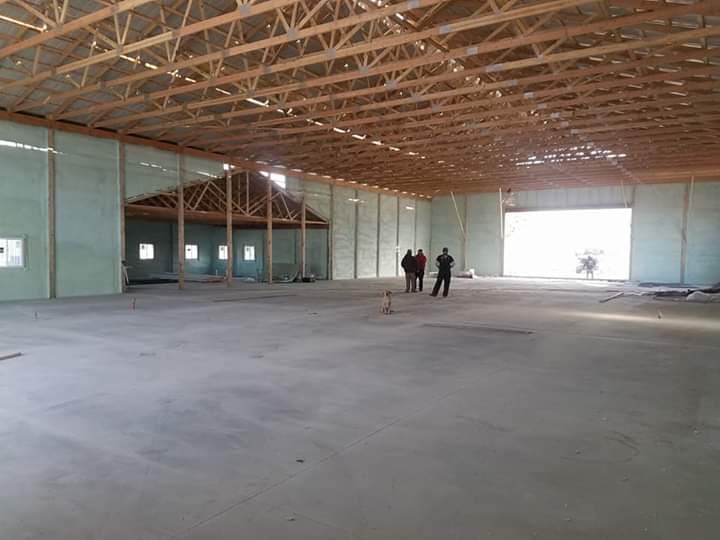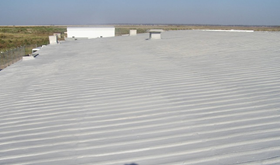Is Spray Foam a Good Choice for Metal Buildings & Metal Roofs?
Who’s Telling the Truth?

Contrary to a myth that SPF should not be applied to metal buildings or metal roof decks, the following article will demonstrate conclusively that SPF is an excellent product for solving a number of issues that are inherent in metal building and metal roof decking. Misinformation abounds on the Internet So, how do you know whether or not the article or ad you are reading is telling the truth? One of the best ways to know if what you are reading is true and accurate is to see if the article or ad contains any hard data, documented case studies and/or professional references. Without credible evidence to back up a claim, there is nothing to support the information that is being conveyed.
How Does Misinformation about SPF Arise on the Internet?
A few companies that compete with spray foam sometimes look for ways to sway readers away from that product so they will purchase their products instead. They make attempts to downplay the benefits of spray foam or are less than truthful about what they are telling you. It isn’t that they all mean to lie to you. Some may simply be misinformed. They may be lacking in-depth knowledgeable about spray foam and are unable to discuss the subject on a professional level. Therefore, they tend to oversimplification the subject in an attempt to make their arguments appear valid. Sometimes they talk about spray foam as if there is only one kind, making blanket statements that they apply to all spray foam products. Such blanket statements are a clear indication that the writer does not have a full understanding of what he or she is talking about.

What Do the Nay-Sayers Say about Spray Foam for Metal Buildings?
One of their main complains from nay-sayers is that metal buildings are subject to condensation and that spray foam will not solve condensation, heat or cold problems for metal buildings. Metal building are subject to condensation—this part is true. Now, let’s look what recognized SPF professionals have to say about this subject:
“Closed-cell SPF has a significant history of use with metal building systems, including metal roofing and cladding assemblies. This paper reviews the application of ccSPF for roofing in new, retrofit and renovated building projects, and discusses the significant benefits associated with such practices – in particular, for high-performance insulation and moisture control. Closed-cell SPF is ideally suited to metal building applications due to its light weight, durability, and conformability to virtually any surface geometry. More important, however, ccSPF adds a number of high-performance attributes to metal roofing and cladding assemblies, including: high R-value thermal insulation, good acoustical performance, and reduced uncontrolled air infiltration and exfiltration – which can lead to improved indoor air quality (IAQ). In addition, ccSPF is self-flashing and sealing, provides good wind uplift resistance, high compressive strength, increased racking strength, and lowered roof surface temperatures,” Insulation and Waterproofing for Metal Buildings & Metal Roof Systems: The case for using better insulating and waterproofing technologies in metal roof systems and metal buildings, Knowles and Tucker, 2004.
Notice that the quote above is accompanied by a reference from recognized industry professionals and is cited at the end of the statement. Now, anyone can look up this reference and read the entire article for themselves.
Nay-sayers complain about the cost and practicality of using SPF for metal buildings and roof decking. Once again, here is what the professionals say:
“Costs and Considerations: Properly designed and installed, ccSPF can provide a solution for metal building and metal roof concerns. The material is sprayed onto a surface as a liquid. Within seconds, the foam– while still in a fluid-like state – expands 30 to 40 times its original volume to form a lightweight insulation. In this way, the material fills in cracks, crevices and areas that are difficult to reach with other materials.
There are two ways to effectively use ccSPF in metal buildings:
(1) installed as a roofing system or insulated exterior wall covering, or
(2) installed to the interior walls and ceiling of the metal building.
Each of these options has distinctive benefits, and a number of factors determine which system to use for a specific metal building project. In all cases, however, the use of ccSPF can be highly cost-effective. According to RS Means cost data, replacing metal roofing and wall panels can cost $10 to $13 per square foot (sq. ft.), whereas a ccSPF application can range from $3 to $5 per sq. ft.,” Knowles and Tucker, 2004.
Note that this article was written in 2004; therefore, the numbers for costs may be different for 2019; however, the cost-benefit is still the same.
Where to Find More Professional Resources
Professional and scholarly publications, that include cases studies and hard data about applying spray foam in and on metal buildings can be found throughout books and articles written by engineers, chemists, architects, building science experts, recognized industry professionals and professional industry organizations, such as NRCA (National Roofing Contractors Association) Application Guidelines and Standards and SPFA (Spray Polyurethane Foam Alliance) which has a technical committee. ABAA (Air Barrier Association of America) has a mentoring program. Others expert resources include ATI, Architectural Testing Inc., York, PA. ATI is a full-service lab that certifies building products and assemblies for commercial use, BASF, Honeywell, National Research Council of Canada, “Insulation and Waterproofing for Metal Buildings & Metal Roof Systems”, “Insulation and Waterproofing for Metal Buildings & Metal Roof Systems: The Case for Using Better Insulating and Waterproofing Technologies in Metal Roof Systems and Metal Buildings”, by Mason Knowles and Rick G. Tucker, “Guideline for Insulating Metal Buildings with Spray Applied Polyurethane Foam” written by SPFA’s Technical Committee, and Dr. Mark Bomberg has conducted and written research studies, case studies and published hard data. Information is abundant on this subject. You just need to know where to look. Keep in mind that the list of references mentioned above is not all inclusive. There are many articles on this subject that can also be found throughout a number of recognized industry organizations.
Dr. Bomberg on the Subject of SPF for Metal Buildings
If you are not familiar with Dr. Mark Bomberg, please do yourself a favor and get to know his work. He is an excellent resource for building science questions. Let’s look at what Dr. Bomberg has to say about the benefits of SPF application for climate and moisture control in buildings.
“Dr. Bomberg specifically pointed out the valuable contribution ccSPF could make in climate and moisture control in buildings when installed to the interior of buildings by providing the following building environmental control functions: • Providing a continuous air barrier. • Preventing moisture infiltration through air leakage. • Minimizing dew point problems and condensation within the building. • Avoiding thermal bridging. Resisting heat movement in all directions. • Providing reliable performance under varying climatic conditions,” in Knowles and Tucker, 2004. Dr. Bomberg is on the faculty of Engineering at Lund University. He has written and published many articles on the subject of building science including spray foam applications for metal buildings and metal roof decking.
Why SPF is a Good Choice for Metal Roof Decking?
A problem inherent with many metal roofs decks is thermal shock. Moreover, the color used on metal roof decks can affect the amount of heat absorption or reflected. Let’s see how applying SPF solves these problems:
“Movement due to thermal shock: Metal expands and contracts with varying ambient temperatures, causing fasteners to wear and pull out, flashing to delaminate and separate, metal panels to separate, and welds to break loose – which can cause roofs to start leaking. Serious water damage and loss of structural integrity can be the result.
Installed in a roofing system, ccSPF eliminates thermal shock movement by providing a continuous layer of a highly effective insulation above the roof deck. Metal is an effective heat conductor. Lawrence Berkeley National Laboratories has measured dark colored roof substrates up to 190 degrees F on a 95 degree F day, and up to 160 degrees F on a dark, gray-colored surface (the color of most metal roofs). Research conducted by Dr. Mark Bomberg of Syracuse University demonstrates that the application of a seamless, continuous insulation on top of the metal roof deck and metal framing members reduces the temperature differential between the roof metal deck and the interior temperatures. This in effect “puts the roof to sleep,” minimizing thermal expansion and contraction caused by varying temperatures. Insulation and Waterproofing for Metal Buildings & Metal Roof Systems,” Knowles and Tucker, 2004.
Be aware that the few quotes use in this article are not all-inclusive on this subject. There are hundreds, if not thousands, of professional articles that address the benefits of applying SPF to metal buildings and metal roof decks.
Always Remember to Ask Yourself, “Where is the Evidence?”
Throughout the professional references listed above, nothing is said that would lead anyone to believe that spray foam is not a good choice for metal buildings or metal roof decking. On the contrary, when SPF is applied correctly by a professional, spray polyurethane foam is an excellent choice for both insulating and waterproofing mental buildings and metal roof decks. The many benefits of SPF are backed up by a mountain of evidence that is hard to poke holes in. Suppliers of products that compete with spray foam would like nothing better than to get people to stop buying spray foam and buy their products instead. Please understand that there are other good products on the market; however, there is no need to alter the truth, skew the facts or speak with misinformation to make a point. Those who resort to negative tactics are perhaps more the exception than the rule. Hard data backed up with legitimate research tells the story. Reputable suppliers of alternative products often do include hard data to back up their information. Kudos to them. So, the next time you read something negative about SPF, consider who is writing the article and what their underlying motives may be for making such claims. And, always remember to ask yourself, “Where is the evidence?”
Spray Foam Insider would like to give special thanks to Mason Knowles for contributing references and resources for this article.
Mason Knowles is the President of Mason Knowles Consulting LLC, a consulting company specializing in providing technical information, education and training for the SPF industry. He has more than 48 years of experience in the spray polyurethane industry as a consultant, contractor, material supplier/manufacturer, equipment manufacturer and trade association professional. Knowles is a member of Spray Polyurethane Foam Alliance (SPFA), Insulation Contractors Association of America (ICAA) and contributes frequent web-based presentations on SPF issues. He is a SPFA Certified Field Examiner, Chair of SPFA Consultant’s Committee, accredited building envelope and roofing inspector and instructor. Knowles chaired the ASTM committees on SPF roofing (D08.06) and standard specification for closed cell SPF (C-1029) for 20 years. He regularly writes articles for national trade journals, provides presentations for trade groups and other organizations on the SPF industry.





